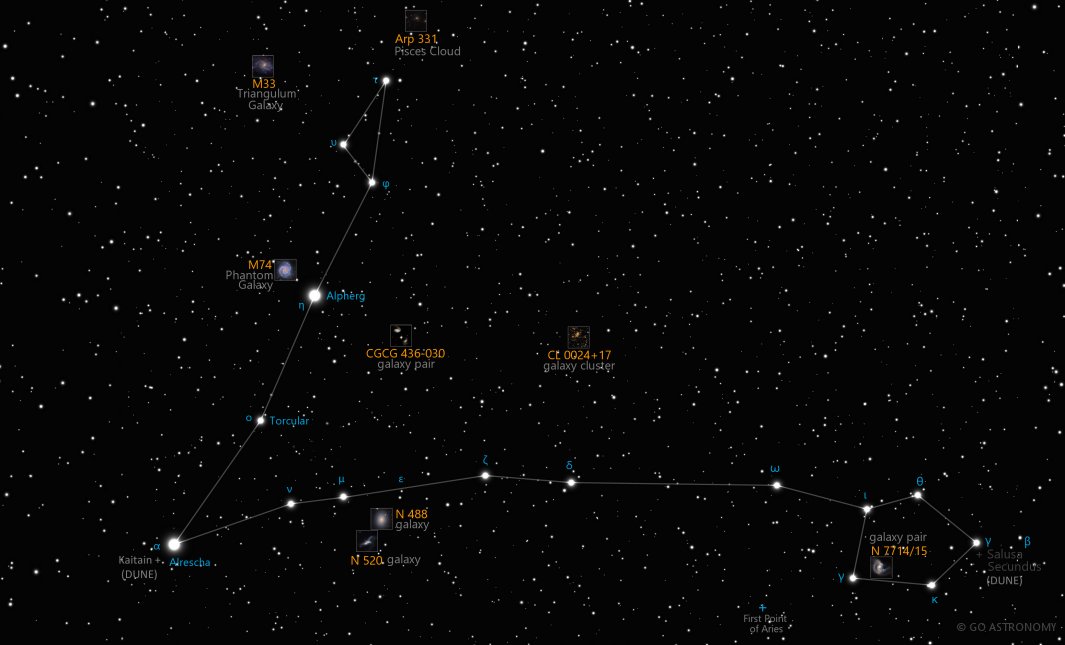Pisces, the Fishes (Psc)
(PICE-eez)
The Northern constellation of Pisces, the Fishes, is best viewed in Fall during the month of November.
Pisces is the 14th largest constellation. It's brightest star is Alpherg at magnitude 3.62. The boundary of the Pisces constellation contains 18 stars that host known exoplanets.
Pisces is an equatorial constellation, which means its bulk intersects the celestial equator or comes within 10-15 degrees of doing so. Pisces is visible from most places on Earth.
- Pronunciation:
- PICE-eez
- Meaning:
- Fishes
- Genitive:
- Piscium
- Abbreviation:
- Psc
- Constellation Family:
- Zodiacal
- Hemisphere:
- Northern
- Quadrant:
- NQ1
- Visibility:
- 90° N - 65° S
- Best viewing month*:
- November
- Area:
- 889 sq. degrees
- Size:
- 14th largest
- Equatorial:
- Yes
- Right Ascension (avg):
- 0h 53m
- Declination (avg):
- 11°
- Brightest star:
- Alpherg (3.62)
- Stars with planets:
- 18
- Caldwell objects:
- |
Brightest Stars in Pisces
The 10 brightest stars in the constellation Pisces by magnitude.
- Star
- Magnitude
- Spectral class
- Eta Piscium (η Psc)
- 3.62
- G8III
- Gamma Piscium (γ Psc)
- 3.7
- G7III
- Omega Piscium (ω Psc)
- 4.03
- F4IV
- Iota Piscium (ι Psc)
- 4.13
- F7V
- Omicron Piscium (ο Psc)
- 4.26
- K0III
- Epsilon Piscium (ε Psc)
- 4.27
- K0III
- Theta Piscium (θ Psc)
- 4.27
- K1III
- Alpha Piscium (α Psc A)
- 4.33
- A0p
- 30 Piscium (30 Psc)
- 4.37
- M3III
- Delta Piscium (δ Psc)
- 4.44
- K5III
Double Stars in Pisces
These are the brightest and easiest-to-find double, triple, and quadruple star systems in the constellation Pisces. Also see all star clusters.
- Star system
- Magnitudes
- Type
- 65 Piscium
- 6.3, 6.3
- double
- Psi 1 Piscium
- 5.3, 5.4
- double
- Zeta Piscium
- 5.2, 6.3
- double
- Alpha Piscium
- 4.1, 5.2
- double
Galaxies in Pisces
The most notable galaxies in the constellation Pisces. Also see all galaxies.
- Name
- Alt name
- Type
- Pisces Cloud
- galaxy group
- Pisces Dwarf
- dwarf
- Arp 157
- galaxy pair
- Arp 284
- galaxy pair
- CGCG 436-030
- galaxy pair
- CL 0024+17
- galaxy cluster
- NGC 524
- lenticular
- NGC 660
- ring
- Phantom Galaxy
- M74
- spiral
Milky Way Satellites in Pisces
Dwarf satellite galaxies that orbit the Milky Way Galaxy located in the constellation Pisces. Also see all Milky Way satellite galaxies.
- Galaxy name
- Alt name
- Magnitude
- Pisces II
- Pisces I
The Fish of the Night Sky
Among the constellations of the zodiac, Pisces holds a unique place. Representing two fish connected by a cord, Pisces has been a staple of star maps since ancient times. Its stars may not be the brightest, but the constellation's historical significance and its position along the ecliptic make it a fascinating subject for astronomers and skywatchers alike.
Historical Background
Pisces has been recognized as a constellation for thousands of years. The Ancient Greeks knew it as the Ichthyos, the fish that helped Aphrodite and her son Eros escape the monster Typhon. The symbol of the fish, represented in the constellation, was adopted by early Christians as a secret symbol. As one of the twelve constellations of the Zodiac, Pisces has always held a significant place in astrology as well.
Location and Main Features
Pisces is located in the first quadrant of the Northern Hemisphere (NQ1), but it can be seen at latitudes between +90? and -65?. It's bordered by several other constellations, including Andromeda and Pegasus to the north, Aries to the east, and Aquarius to the south. With an area of 889 square degrees, Pisces is the 14th largest constellation in the night sky.
Main Stars in Pisces
Despite its size and recognition, Pisces is relatively faint, with no star brighter than fourth magnitude. Its brightest star, Eta Piscium, also known as Alpherg or Kullat Nunu, is a giant star located about 294 light-years from Earth, with an apparent magnitude of 3.62. Other notable stars include Alpha Piscium (also known as Alrescha, "the cord") which represents the knot of the cord that binds the two fish, and Omega Piscium, a beautiful binary star that can be split in small telescopes.
Deep Sky Objects
Pisces also hosts a few notable deep-sky objects. These include M74, a beautiful face-on spiral galaxy that's among the faintest Messier objects, making it a challenge for amateur astronomers to observe. Another interesting object is the Pisces Dwarf galaxy, a dwarf irregular galaxy that's part of the Local Group of galaxies, which also includes the Milky Way.
Observation
Pisces is best observed in November, but its stars can often be hard to see from light-polluted areas due to their faintness. From mid-northern latitudes, Pisces is visible in the southern sky in the evening from late summer through fall. Because it's located along the ecliptic, Pisces is also where the plane of the solar system intersects the celestial sphere, making it a frequent backdrop for the Sun, Moon, and planets.
* Constellation shown for northen hemisphere skies. For the southern hemisphere, constellations appear rotated 180 degrees (upside-down and left-right reversed) from what is shown. Remember that seasons are reversed too - summer in northern latitudes is winter in southern latitudes.
** Circumpolar constellations are visible year-round in the hemisphere listed (and not at all in the opposite hemisphere).





